Englert and Higgs win Nobel physics prize (Update 4)
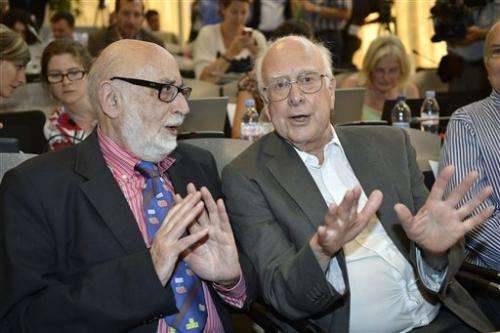
Nearly 50 years after they came up with the theory, but little more than a year since the world's biggest atom smasher delivered the proof, Britain's Peter Higgs and Belgian colleague Francois Englert won the Nobel Prize in physics Tuesday for helping to explain how matter formed after the Big Bang.
Working independently in the 1960s, they came up with a theory for how the fundamental building blocks of the universe clumped together, gained mass and formed everything we see around us today. The theory hinged on the existence of a subatomic particle that came to be called the Higgs boson—or the "God particle."
In one of the biggest breakthroughs in physics in decades, scientists at CERN, the European Organization for Nuclear Research, announced last year that they had finally found a Higgs boson using the $10 billion particle collider built in a 17-mile (27-kilometer) tunnel under the Swiss-French border.
In a statement issued by the University of Edinburgh, where he retired as a professor, the famously shy, 84-year-old Higgs said he hoped the prize would help people recognize "the value of blue-sky research."
Englert, 80, said the award pointed to the importance of scientific freedom and the need for scientists to be allowed to do fundamental research that doesn't have immediate practical applications.
"You don't work thinking to get the Nobel Prize," said Englert, a retired professor at the Free University of Brussels. Still, "we had the impression that we were doing something that was important, that would later on be used by other researchers."
The Nobel selection committees are notoriously cautious, often allowing decades to elapse before honoring a scientific breakthrough, and their choices are hard to predict. But this time, the prize went to people who were widely expected to get it.
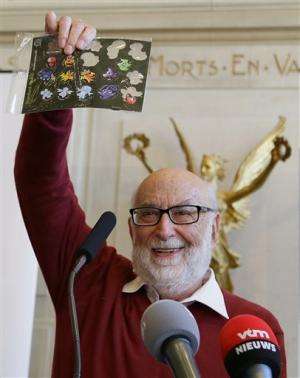
"In CERN here, most all of the physicists I know, about 95 percent, expected those two would win it. The question was if there would be a third and who it would be," said Joe Incandela, a professor of physics at the University of California at Santa Barbara and leader of the CMS experiment, one of the two groups that discovered the Higgs particle.
Before the announcement, there had been questions over whether a group of American scientists who published a paper shortly after Higgs would also be honored, or whether any of the thousands of scientists at CERN would share in the prize, too.
But that would have been a tricky decision for the judges, since each Nobel Prize can go to only three winners.
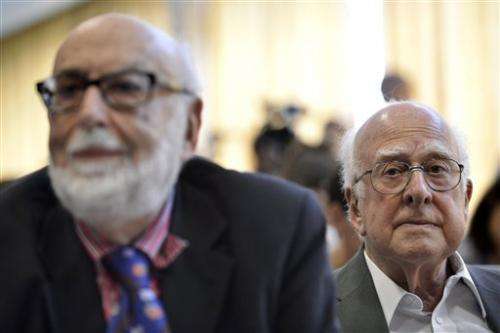
Ulf Danielsson, a member of the Royal Swedish Academy of Sciences, which awards the physics prize, noted that the prize citation also honored the work done at CERN.
"This is a giant discovery. It means the final building block in the so-called Standard Model for particle physics has been put in place, so it marks a milestone in the history of physics," Danielsson said.
The two winners will share a prize worth 8 million Swedish kronor ($1.2 million). The Nobel Prizes, established by Swedish industrialist Alfred Nobel, have been given out since 1901.
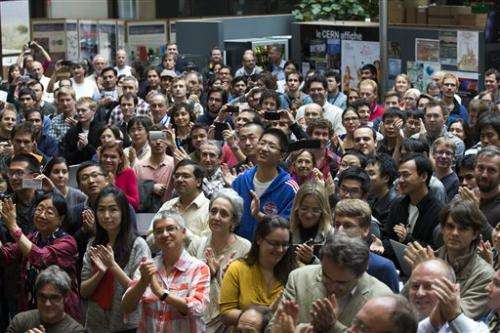
CERN Director General Rolf Heuer said he was thrilled for Higgs and Englert, while many of the thousands of scientists who worked there broke into applause when the announcement was made after an unusual—and unexplained—one-hour delay. (It could be a while before the world finds out the reason for the delay, because the academy's deliberations are kept secret for 50 years.)
Englert and Higgs were trying to provide an answer to a riddle: How did matter form soon after the Big Bang?

They proposed the existence of an invisible field that sprawls through space like a net. The building blocks of matter, they suggested, acquired mass when this field trapped them. Much later, as the universe cooled, they formed atoms that eventually became stars and planets.
To detect the field, the scientists suggested looking for the Higgs boson, because all fields are associated with a particle. Decades would pass before scientists were able to confirm the existence of this particle.
Only about one collision per trillion will produce a Higgs boson in the giant atom collider, and it took CERN several months after the discovery of a new "Higgs-like" boson to conclude that the particle was, in fact, very much like the one expected in the original formulation.
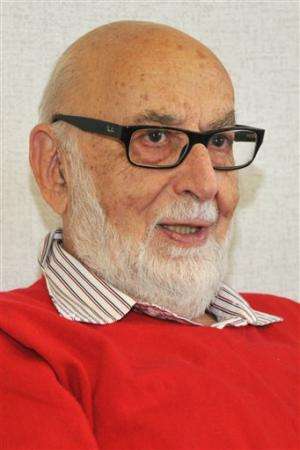
The phrase "God particle" was coined by Nobel-winning physicist Leon Lederman, but it's disliked by most physicists because it connotes the supernatural. Lederman said later that the phrase—mostly used by laymen—was really meant to convey that he felt it was the "goddamn particle," because it proved so hard to find.
Michael Turner, president of the American Physical Society, an organization of physicists, said the Higgs particle captured the public's imagination.
"If you're a physicist, you can't get in a taxi anywhere in the world without having the driver ask you about the Higgs particle," said Turner, a cosmologist at the University of Chicago.

Turner said the Higgs is the first in a class of particles that scientists think played a role in shaping the universe. That means it points the way to tackling mysteries such as the nature of dark energy and dark matter, he said.
The physics prize was the second of this year's Nobels to be announced. On Monday, the Nobel in medicine was given to U.S. scientists James Rothman, Randy Schekman and Thomas Sudhof for discoveries about how key substances are moved around within cells.
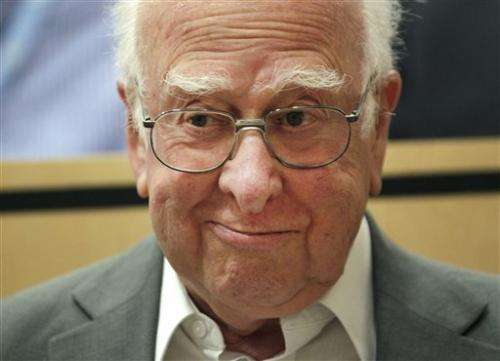
The Nobel Committee Prize Announcement
François Englert and Peter W. Higgs are jointly awarded the Nobel Prize in Physics 2013 for the theory of how particles acquire mass. In 1964, they proposed the theory independently of each other (Englert together with his now deceased colleague Robert Brout). In 2012, their ideas were confirmed by the discovery of a so called Higgs particle at the CERN laboratory outside Geneva in Switzerland.
The awarded theory is a central part of the Standard Model of particle physics that describes how the world is constructed. According to the Standard Model, every thing, from flowers and people to stars and planets, consists of just a few building blocks: matter particles. These particles are governed by forces mediated by force particles that make sure everything works as it should.The entire Standard Model also rests on the existence of a special kind of particle: the Higgs particle. This particle originates from an invisible field that fills up all space. Even when the universe seems empty this field is there. Without it, we would not exist, because it is from contact with the field that particles acquire mass. The theory proposed by Englert and Higgs describes this process.
On 4 July 2012, at the CERN laboratory for particle physics, the theory was confirmed by the discovery of a Higgs particle. CERN's particle collider, LHC (Large Hadron Collider), is probably the largest and the most complex machine ever constructed by humans. Two research groups of some 3,000 scientists each, ATLAS and CMS, managed to extract the Higgs particle from billions of particle collisions in the LHC.
Even though it is a great achievement to have found the Higgs particle—the missing piece in the Standard Model puzzle—the Standard Model is not the final piece in the cosmic puzzle. One of the reasons for this is that the Standard Model treats certain particles, neutrinos, as being virtually massless, whereas recent studies show that they actually do have mass. Another reason is that the model only describes visible matter, which only accounts for one fifth of all matter in the cosmos. To find the mysterious dark matter is one of the objectives as scientists continue the chase of unknown particles at CERN.

Nobel physics: A closer look at the Higgs boson
So what is the Higgs boson, the elusive particle that physicists Peter Higgs and Francois Englert theorized about and won the Nobel Prize for on Tuesday? The subatomic particle—which has also been called the "God particle" by some because it is seen as fundamental to the creation of the universe—has been the subject of an intense scientific hunt at the world's biggest atom smasher near Geneva. Last year, scientists at CERN, the European Organization for Nuclear Research, announced they had finally detected the long-sought particle.
WHAT EXACTLY IS THE GOD PARTICLE?
Everything we see around us is made of atoms, inside of which are electrons, protons and neutrons. And those, in turn, are made of quarks and other subatomic particles. Scientists have wondered how these tiny building blocks of the universe acquire mass. Without mass, the particles wouldn't hold together—and there would be no matter.
One theory proposed separately by Higgs and Englert is that a new particle must be creating a "sticky" energy field that acts as a drag on other particles. Atom-smashing experiments at CERN have since confirmed that this particle exists in a form that is similar to—but perhaps not exactly like—what was proposed.
WHY DOES THIS MATTER?
The Higgs particle is part of many theoretical equations underpinning scientists' understanding of how the world came into being. If the particle didn't exist, then those theories would have needed to be fundamentally overhauled. The fact that it does exist gives more weight to the so-called Standard Model of particle physics, which explains how much of the universe works at the subatomic level. Scientists say there is still work to be done, especially because neutrinos—subatomic particles that were previously thought to be without mass—do now appear to have mass. Researchers are also still trying to figure out how to account for so-called dark matter, the over four-fifths of matter in the universe that can't be seen.
HOW MUCH DID THE HUNT FOR THE HIGGS COST?
CERN's atom smasher, the Large Hadron Collider, is a 17-mile (27-kilometer) tunnel beneath the Swiss-French border that cost some $10 billion to build and run. This includes the salaries of thousands of scientists and support staff around the world who have collaborated on the two experiments that independently pursued the Higgs particle.
WHY SPEND SO MUCH MONEY CONFIRMING A SCIENTIFIC THEORY?
While there haven't been any practical applications from discovering the Higgs boson, the massive scientific effort that led up to its discovery has already paid off in other ways. Researchers at CERN helped develop the World Wide Web to store and exchange ideas over the Internet. The vast computing power needed to crunch all of the data produced by the atom smasher has also boosted the development of cloud computing, which has found its way into the mainstream as sophisticated web applications. Advances in solar energy capture, medical imaging and proton therapy to fight cancer have also resulted from the work of particle physicists at CERN and elsewhere.
More information: www.nobelprize.org/nobel_prize … physicsprize2013.pdf
© 2013 The Associated Press. All rights reserved.


















